Letters from The Desert
Ghost Towns of the Atacama
Many years ago, in the mid-80s, I sneaked into the deserted Royal Albert Dock in London’s East End, while researching an article about the London Docklands Development Corporation. The dock had been closed since 1981, but it looked as it had been evacuated overnight. There were papers strewn across the office, discarded boxes and hessian sacks, and signs in the wind-blown, moaning warehouses that indicated vanished imperial trade routes: Buenos Aires, Nairobi, ‘Tanganyika.’
It was an eerie spectacle, the historical counterpoint to Joseph Conrad’s ironic evocation of the Thames as the gateway to Empire, carrying ‘hunters for gold, pursuers of fame, they had all gone out on that stream, bearing the sword, and often the torch, messengers of the might within the land, bearers of a spark from the sacred fire.’
Now, as everyone knew even then, the spark had gone out, and the abandoned dock seemed like a haunted incarnation of imperial decline and Thatcherite financialisation - the hub of empire reduced to mere real estate, soon to be transformed into upmarket housing to serve the City, and a windsurfers’ playground.
Since then I’ve seen a fair amount of ghost towns or ‘dead towns’, as the Sierra Club founder John Muir once described the deserted mining towns of Nevada. I’ve visited bombed villages in El Salvador, abandoned Aragonese hamlets and former French Second Empire spa towns. I’ve also seen photographs of ruined places that course regularly through the Internet. Like many people, I find these ruins irresistible and compelling, because who doesn’t love a good ghost town?
Nowadays we seem to love them more than ever. Some writers have used the terms ‘ruin porn’ or ‘ruin lust’ to describe the 21st century fascination with ruined, decayed places such as Chernobyl, Detroit, or Flint, Michigan. Others have criticised such terms for trivialising the places they describe and the people who once inhabited them.
Whatever you think of the term, it’s difficult to ignore the connection between ‘ruin porn’ and an age haunted by visions of catastrophe. Because when we run out of real ghost towns, we are constantly imagining and re-imagining them, in zombie-haunted shopping malls, airports, and post-pandemic city scapes.
On the one hand, these places are testaments to the fragility and transience of human communities, dreams and projects. They remind us that an unforeseen disaster, or a change in economic fortune can reduce proud cities, towns and villages to haunted relics.
In providing anxious indicators of our own possible future, ruins and ghost towns also provide a gateway into the past - a gateway shrouded with mystery. Who were the people who left in such a hurry, scattering papers on office floors, leaving tables still laid, empty theatres, shops and services? Why did they leave and where did they go?
The Atacama is filled with dozens of pueblos fantasmas (ghost towns). Most of them are mines and former oficinas salitreras (nitrate factories) and accompanying company towns. Some are bare ruins and stumps of walls, the remnants of mining settlements whose names have been forgotten:
Others, like Humberstone, near Iquique have become UNESCO World Heritage Sites:
Because this is the Atacama, many of these towns have not decayed as much as they would have anywhere else. In fact, some of them are in such good condition, that you feel they could be inhabited again within a few months, if there was anything to sustain them.
Humberstone was built to serve the nearby salitrera Santa Laura. It once housed 3,500 workers, managers, and their families. It had its own theatre, hospital, hotel, swimming pool, pulperia (bar-cum-grocery stores) and school (divided into separate classrooms for English and Spanish children). It had houses for the workers, which varied in size according to whether they were married or single.
As a designated national monument and world heritage site, much of Humberstone has been cleaned up and made visitor-friendly. You can have yourselves photographed with smiling mannequins serving at the bar or baking bread – an opportunity that our guide insisted we avail ourselves of.
Humberstone has become a marker of regional identity, and it’s also a packaged, playful version of the past, part-museum and part-tableau, intended to give the visitor the illusion of time-travel - and a goofy selfie with a mannequin.
There is little indication in this tableau of the fierce, harsh labour that the nitrate industry involved. It’s not for nothing that the Atacama, and particularly the Tarapacá region, is viewed as the crucible of the Chilean labour movement. Because extracting nitrate in desert conditions was harsh, backbreaking work, and it was also dangerous - workers often died or suffered serious injuries during the boiling process.
Workers were often lured to the north by false promises of wealth and high wages, only to find themselves isolated in these company towns, paid with the hated ‘fichas’ (tokens) whose value was determined by their employers.
Pablo Neruda later recalled the ‘ men with burned features, their loneliness and remoteness shows in the darkness of their eyes’, who asked him to represent them in the senate in 1944. These miners often went on strike, and when they did, they were likely to be massacred, usually with the approval of the mostly European – particularly British – owners who dominated the nitrate industry.
Yet these remote towns, scattered across the desert, provided European and North American farmers with nitrate fertiliser that enabled them to feed their populations. Nitrate was essential for munitions and dynamite.
Mines and railway tunnels were blown open with Chilean nitrate. In an area in which dynamite became the anarchist super weapon, nineteenth century ‘propagandists of the deed’ also had reason to be grateful for the nitrates of the Atacama.
Had the British navy not sunk the German Pacific fleet in 1914 and cut off German access to the Atacama, Britain would not have had enough explosives to keep the German army at bay on the Western front, and the Schlieffen plan might have succeeded. The British victory forced Germany to adopt the Bosch-Huber method, and industrialise artificial nitrogen, which enabled Germany to survive the war.
That same invention hastened the death of these desert towns, as artificial nitrogen broke the Chilean near-monopoly of nitrates. By the early 1930s, the nitrate industry was already in decline. Though some salitreras lingered on, catering to niche markets, other towns were emptied almost overnight. In her account of the politics and historical memory of the Chilean north Salt in the Sand, Leslie Jo Frazier writes how:
Under state reorganisation, the few nitrate camps that had survived the worldwide economic depression became vulnerable to shifts not only in market demand but also in state policies. From the 1950s to the 1970s, workers were forcibly removed from their homes as the camps were dismantled and sold for scrap in a concession to entrepreneurs.
Though ‘the people of the pampa [desert] demanded work and insisted that their communities not be destroyed’, their protest marches were ignored, and the former salitreras sank into the destitution described by a local poet:
Now that the pampa is is desert without life
Through the government’s own decisions
the dynamite no longer breaks the silence
that was the sonorous song of national strength
This is why the company towns of the Atacama became ghost towns. Like the Royal Albert docks, they are dusty monuments to the rise and fall of economic empires, of markets that came and went, leaving them with no other way to sustain themselves.
A few lasted longer than most. One day, we drove through the desert from the city of Calama to Pedro de Valdivia, the last salitrera to close in the Atacama. Built in 1931 by the Guggenheim Brothers, Pedro de Valdivia once had 14,000 inhabitants, with all the facilities expected of a modern company town: a sports stadium; a cinema-theatre, a hospital, school and children’s playground:
And the inevitable swimming pool:
In 1996, the last inhabitants left the town. Most of them moved to the nearby salitrera town of Maria Elena, 25 kilometres away - the only nitrate plant still functioning. There was a time when Pedro de Valdivia looked like this:
Now, the town has become another national historical monument. You can still the houses where the managers and administrators lived:
And the humbler buildings that housed the workers:
And now the swimming pool looks like this:
Yet every year, the town is visited by the children and grand-children of former residents. Facebook and YouTube videos are often accompanied by expressions of nostalgia for the town, some of which are written by Chileans from as far away as New Zealand. Because the history of these nitrate towns is not just the history of exploitation and class conflicts. Real communities were forged in these towns, with a culture and society that is still a source of pride to pampinos who lived in these towns.
Some of them became concentration camps during the dictatorship. Now, most of them have been abandoned to the desert. And in our synthetic post-modern world that often feels like a perpetual present without a past, there are visitors, like me, who will drive for miles to see these towns, and ponder the lost worlds that they were once part of.
It’s this apparent proximity between past and present that, to my mind, explains their irresistible allure. In terms of our practical ability to be able to ‘go back in time’, something that happened five minutes ago is as inaccessible as something that happened five hundred years ago.
We can remember, but we can never go back.
The ghost towns of the Atacama suggest otherwise. In their dusty streets, abandoned playgrounds, and empty theatres, we feel closer to the people who once inhabited them. Take this street sign, in the abandoned mining town of Chuiquicamata, which proclaims ‘Cecilia is spring’ at the foot of a mountain of copper tailings.
It was erected by friends of a young woman called Cecilia, to boost her chances of winning the ‘queen of spring’ competition.
Cecilia didn’t win. But even though she never became spring, her name remains. And even if none of us who see it will ever know who she was, the sign speaks to us from out of the past.
Like the empty cinemas and playgrounds, we are able to feel a kind of kinship with a living community conjured into existence by flows of commodities and capital. And perhaps part of that kinship stems from the realisation that our own communities - even in our seemingly impregnable megacities - may one day disappear.


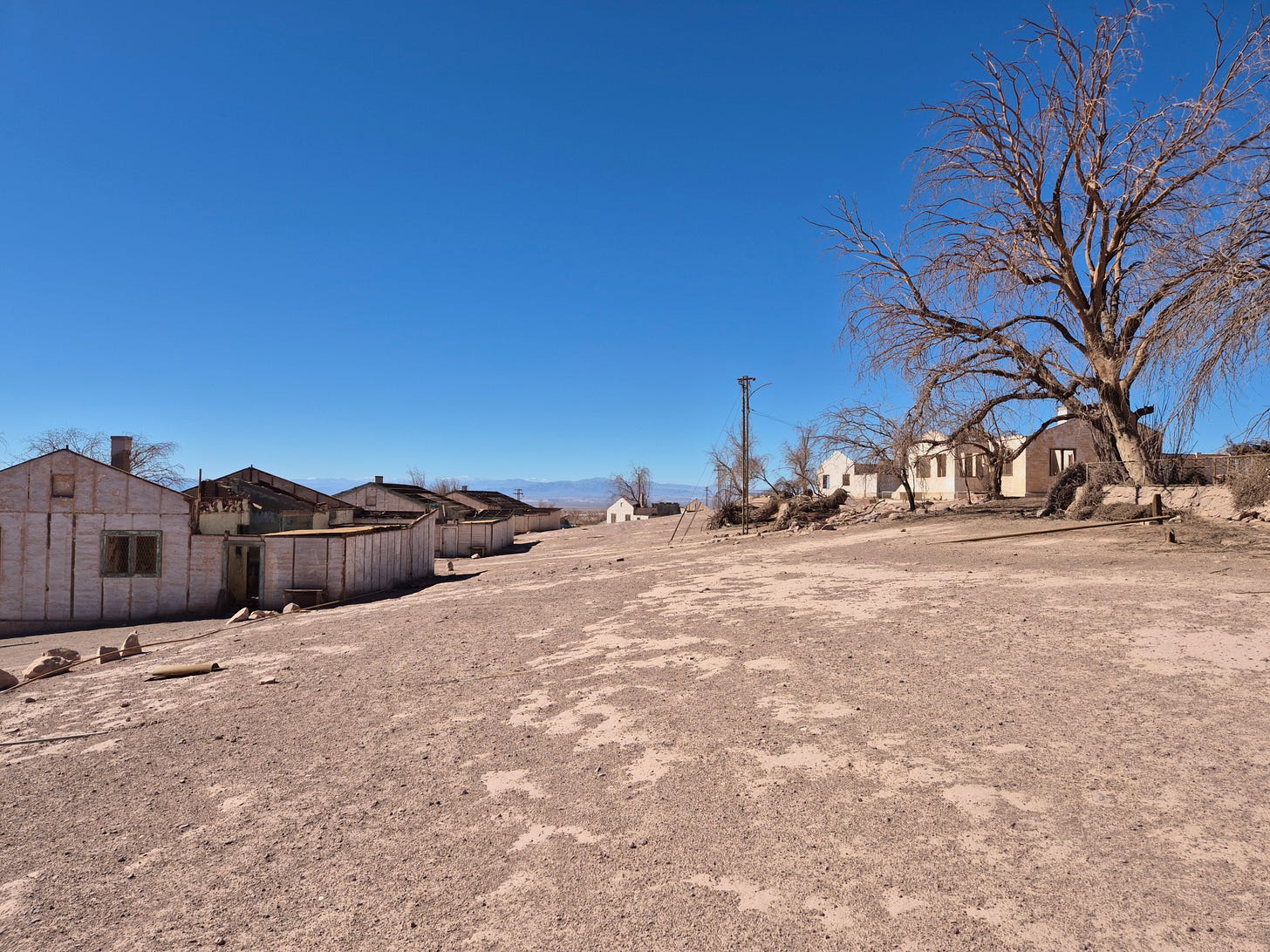
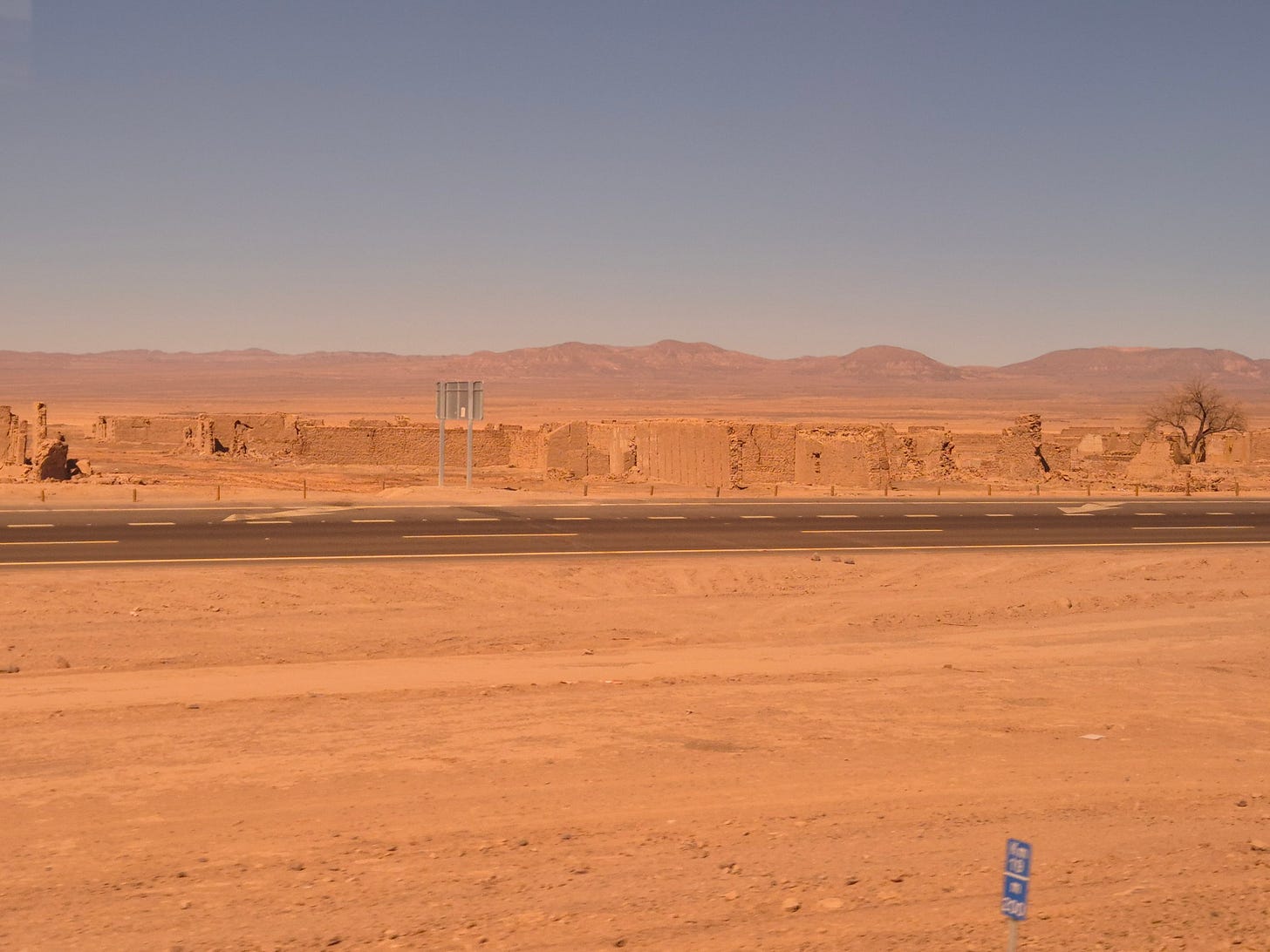
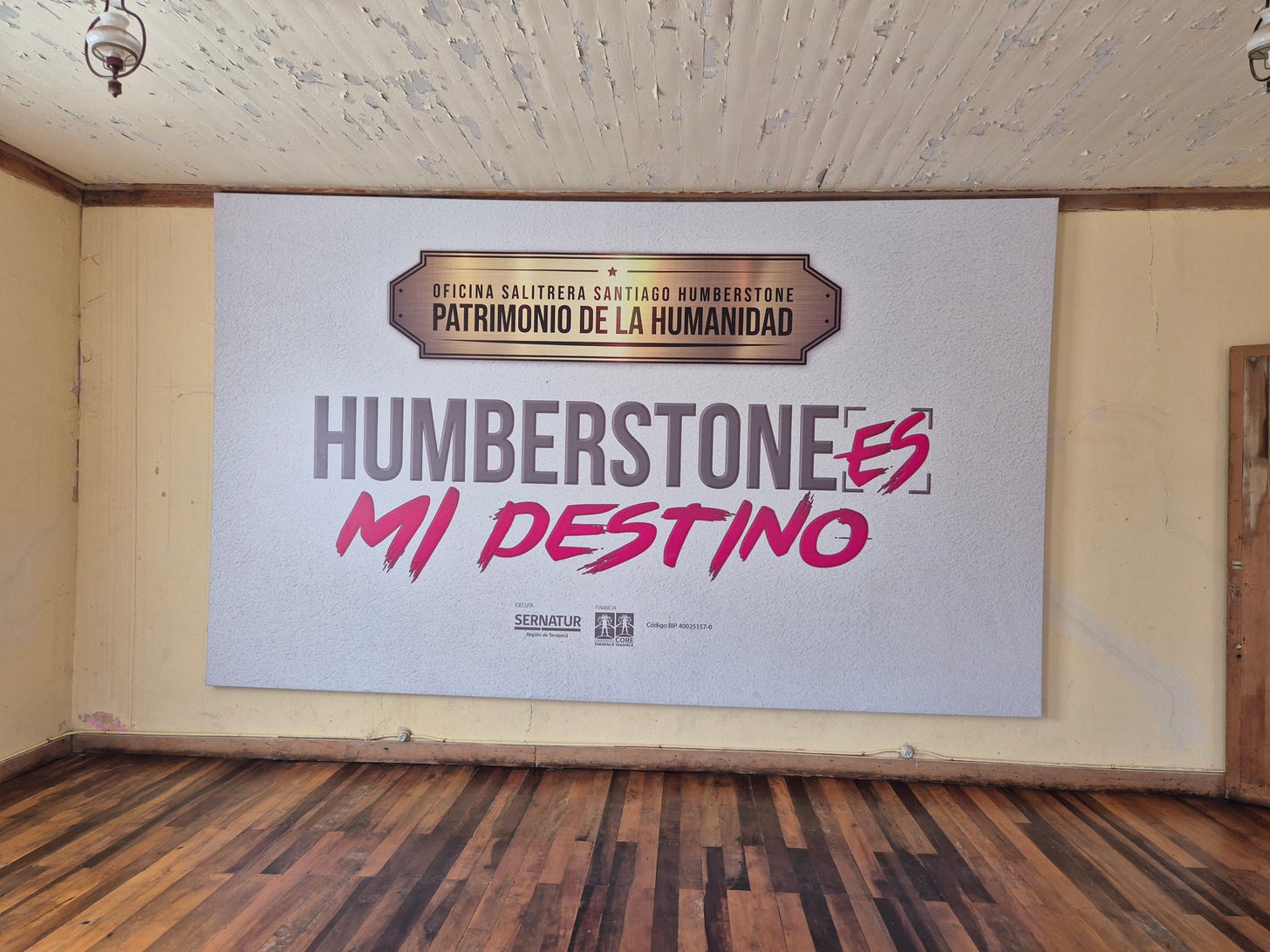
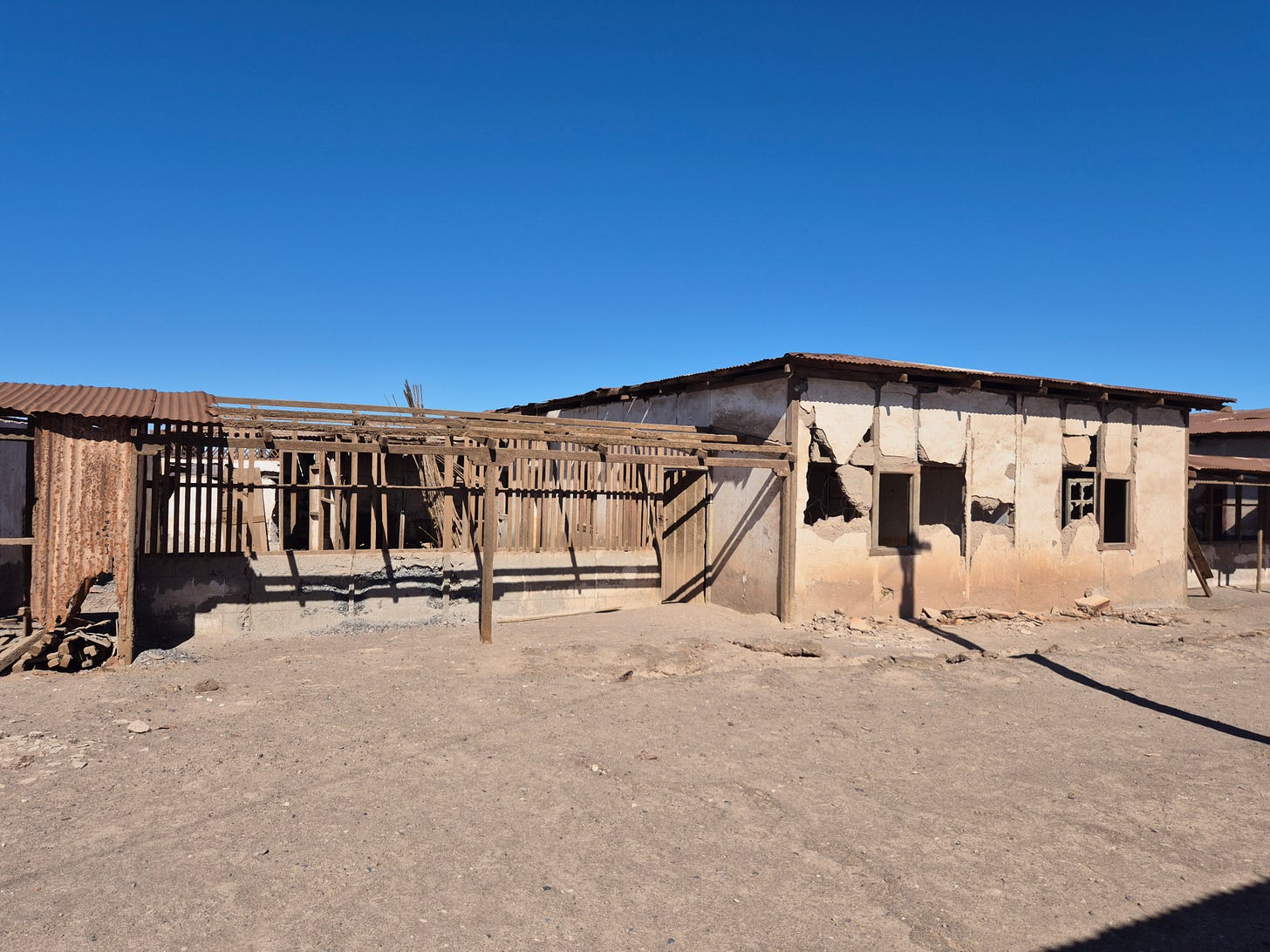
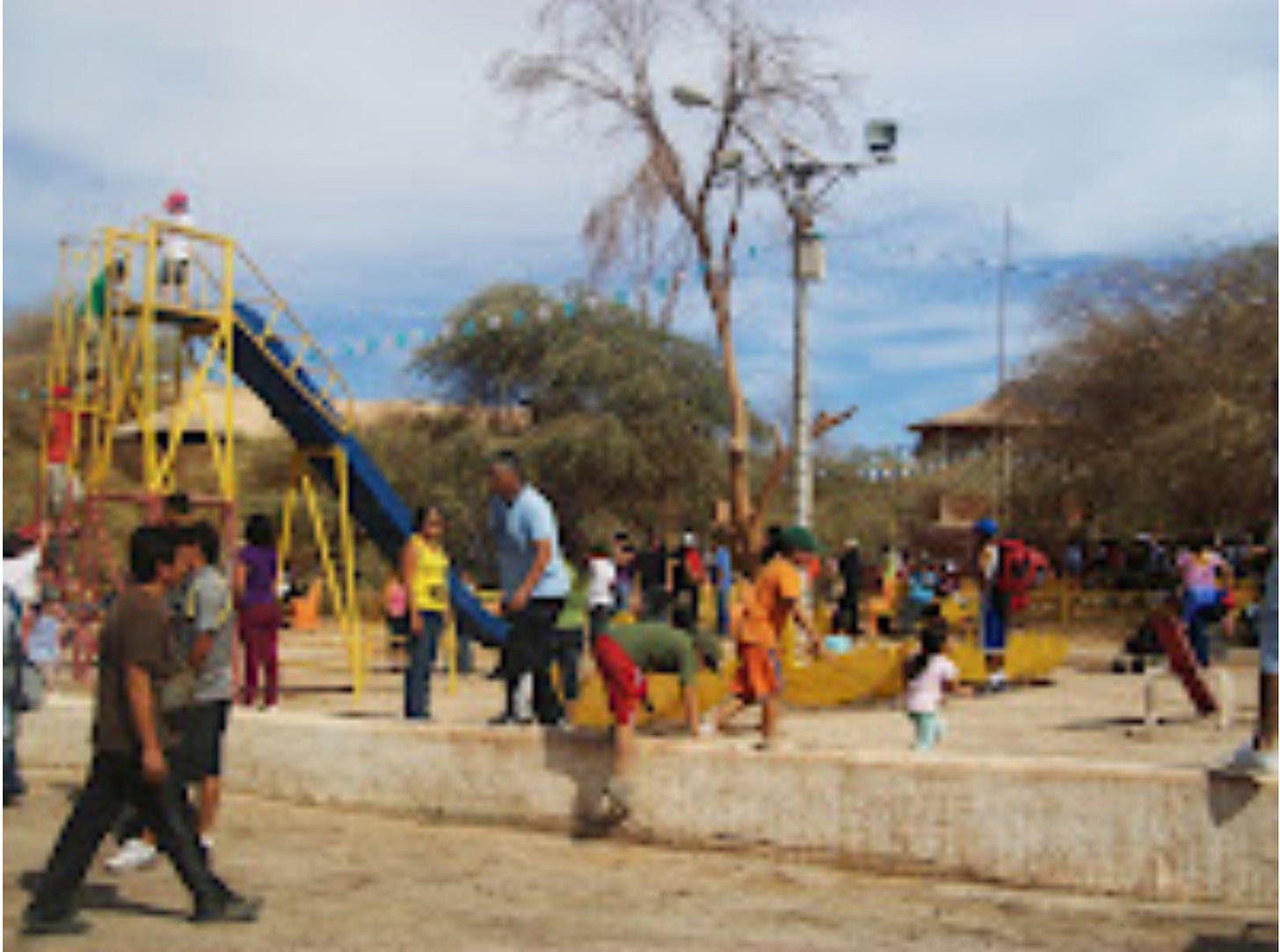
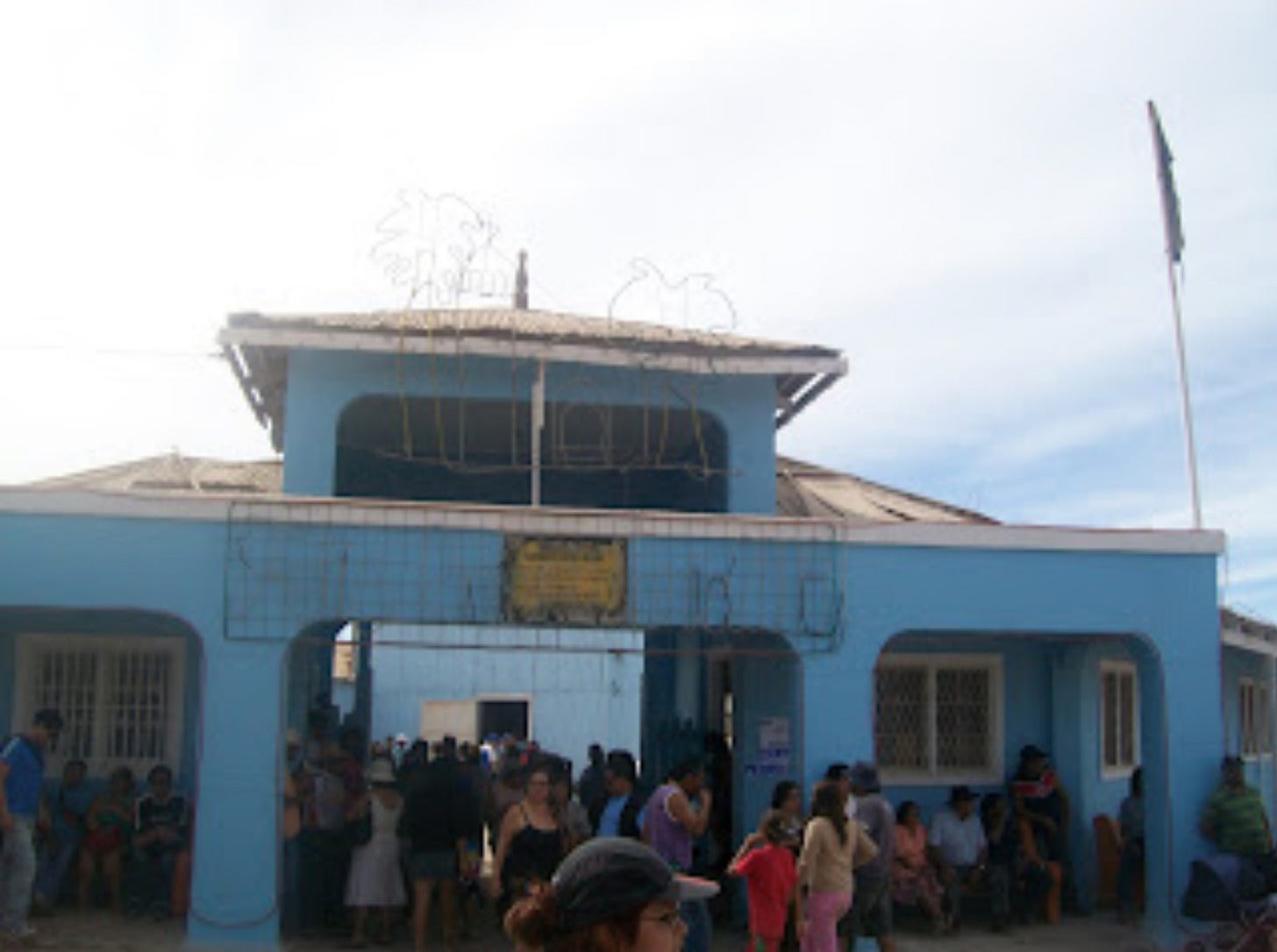
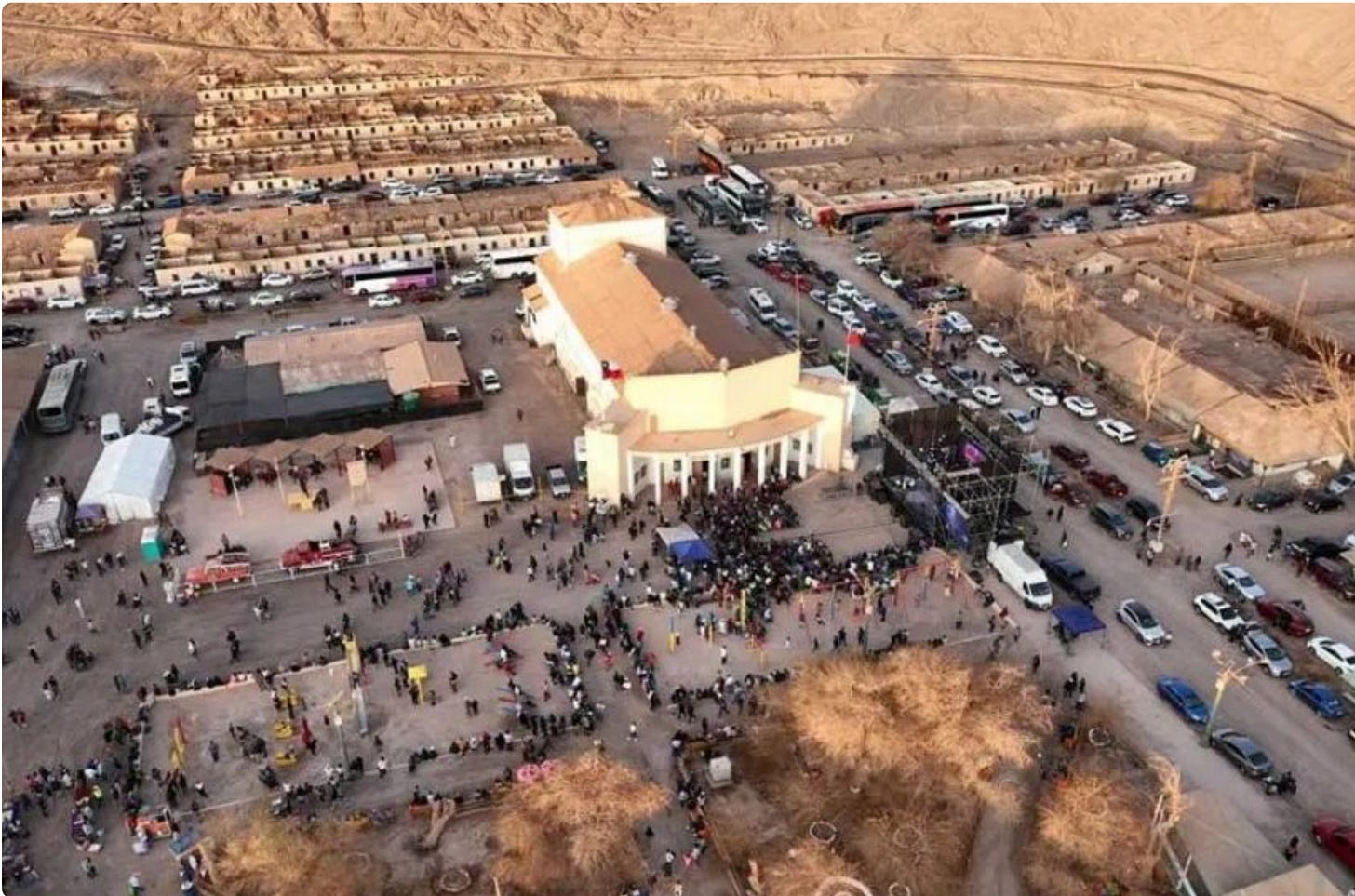
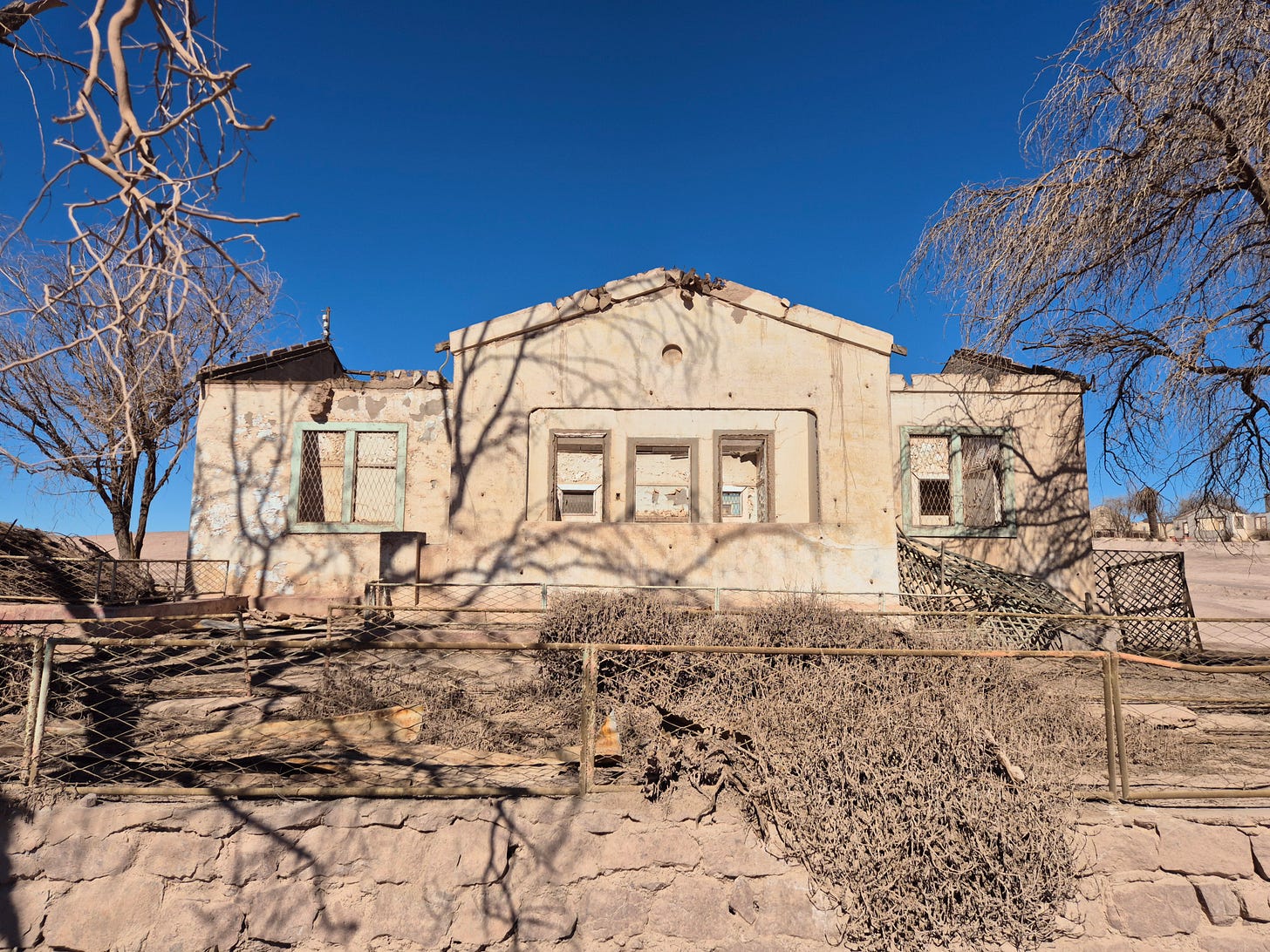
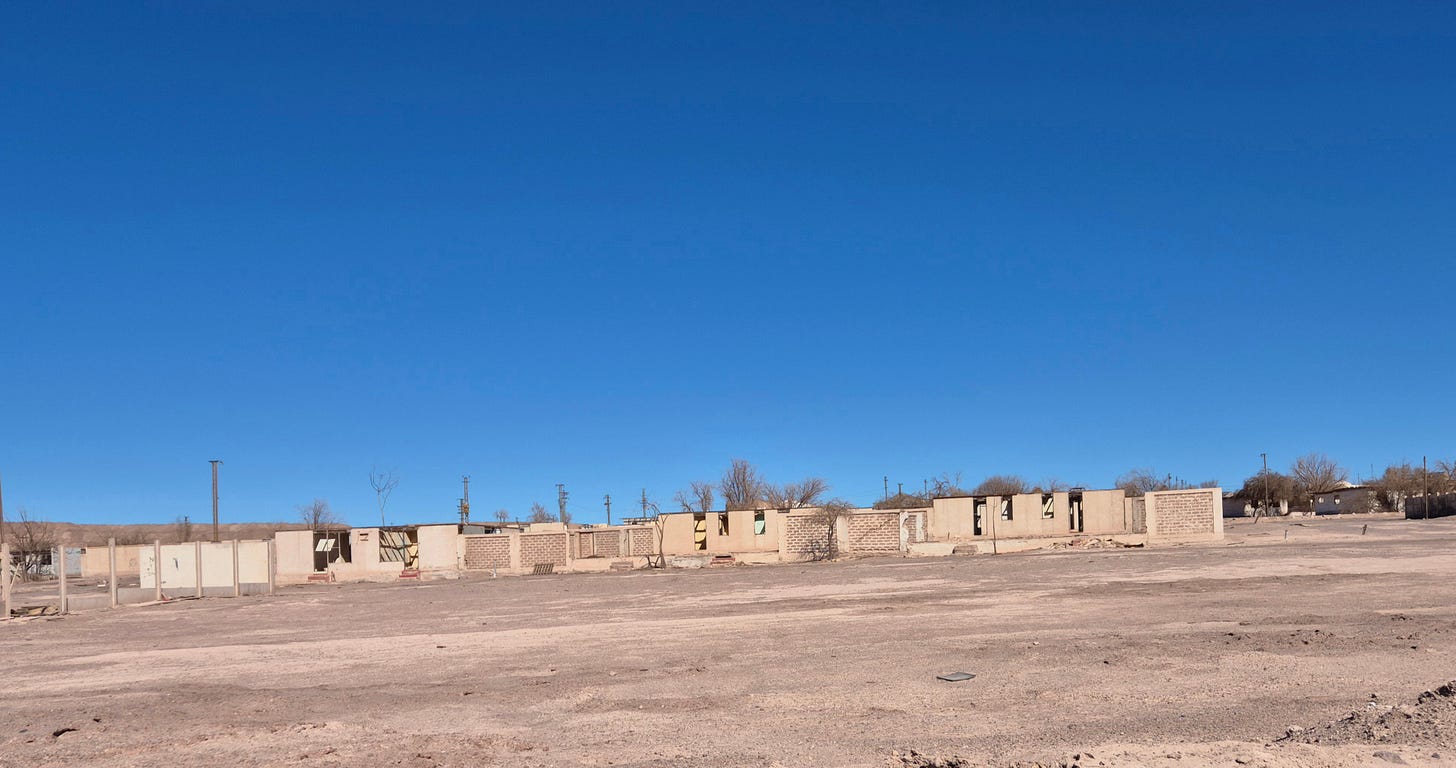
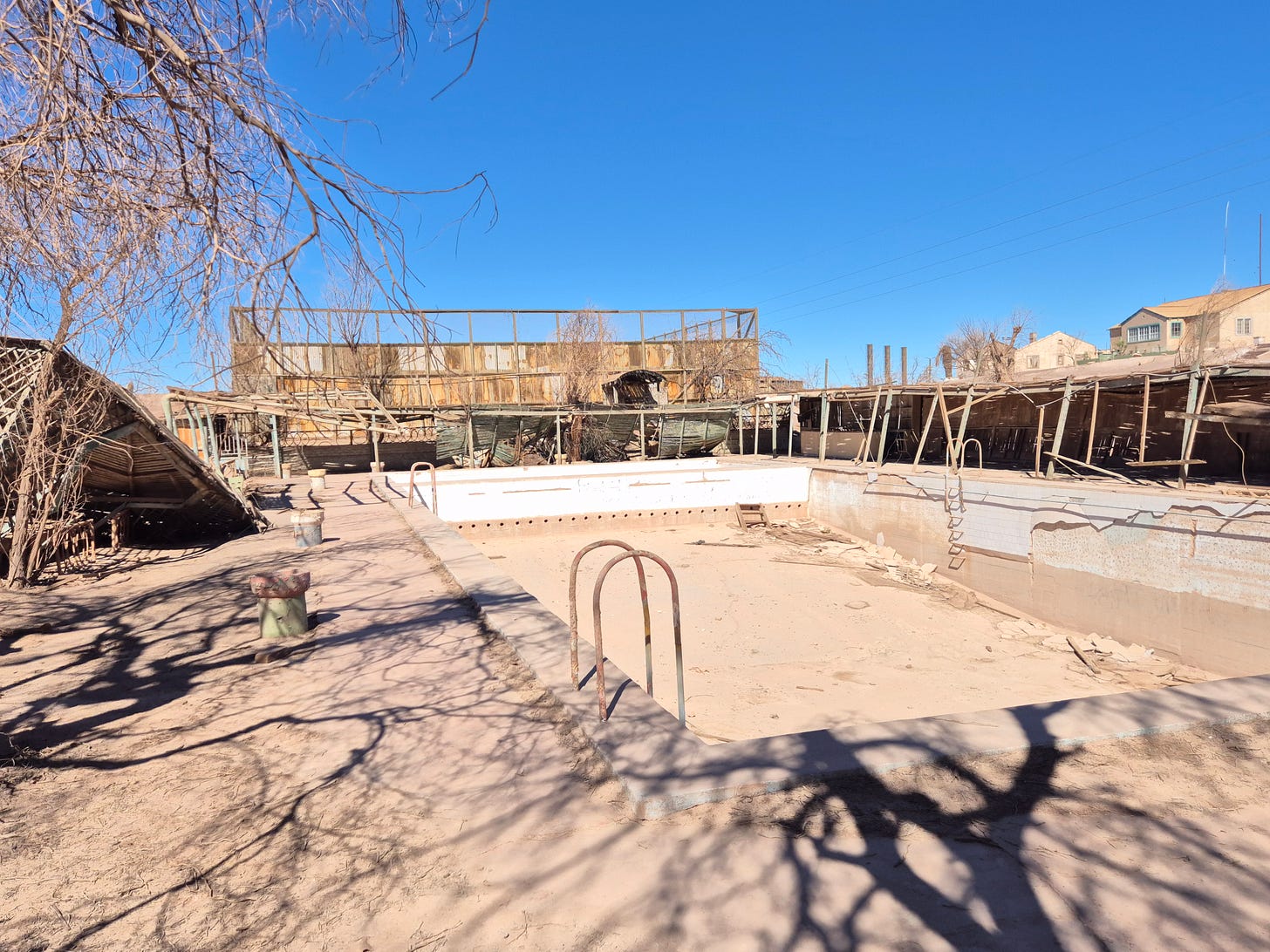
Such atmospheric writing and photographs. There is something about industrial archeology and the tales that it tells of times past. Suspect you may have driven the road from Mendoza up to the Chilean border which passes lots of remains of the railway that used to run there and was replaced by the road. Spectacular abandoned bridges, sidings, sheds and snow tunnels in the midst of stunning scenery. Built when the British were so active in that part of the world.
More to see in the countries of E Europe when during the days of the Russian/Soviet empire, industrial units were built in all sorts of places, I guess to provide local employment. Many now abandoned and providing homes for packs of feral dogs. And great material for keen photographers.
You may have seen this:
https://www.theguardian.com/global-development/2025/jul/17/green-transition-water-chile-atacama-desalination-plants-lithium-copper-mining?CMP=Share_iOSApp_Other